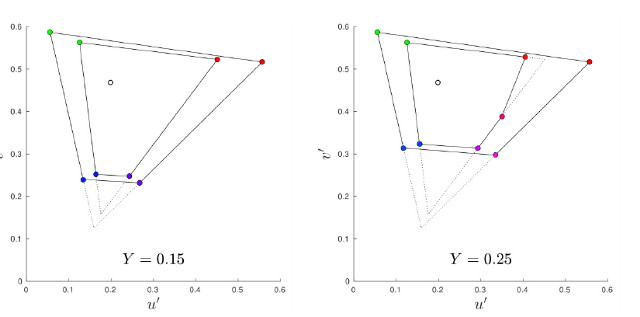One of the important topics covered at the SMPTE conference was conversion from one color gamut to another. This is particularly important when content is encoded using XYZ or BT.2020 coefficients. Such content may be played back on displays with a variety of color gamut support so compressing the original content gamut to the particular display gamut is an emerging need.

The simplest way to do this is to simply clip source colors that are outside of the display’s color gamut. That is, for color outside of the display gamut, the idea is to project the color of that point back toward the D65 white point and find the intersection with the display gamut. That will produce a color of the same hue, but lower luminance, which appears as a desaturated color. This means slight variations in hue are all mapped to the same smaller point, which can mean loss of texture from the original image.
Other color conversion methods seek to preserve the luminance, but can introduce hue shifts. In other words, you can preserve hue or luminance, but not both. New methods that seek to preserve both in color remapping were discussed at the event.
Florian Schweiger of the BBC Research and Development presented a paper in which he noted that color and luminance are not independent, especially at high luminance levels. The full gamut can only be displayed at low luminance levels and this gets progressively smaller with increasing luminance levels (see figure for luminance (Y) of 0.15 and 0.25+ showing decrease in BT.709 and BT.2020 gamuts). As luminance increases, the ability of BT.2020 and BT.709 to reproduce these colors decreases – first in the blue, followed by the red and then the green. At peak luminance values, only the complementary colors – CMY – have an effective gamut.

This is the idea behind the BBC paper – when projecting source gamut colors to smaller gamuts, use the “effective” gamut at the source’s luminance level. This will create a better conversion and produce a converted color that is closer in perceived luminance and color to the original. To perform “soft clipping” and preserve some of the subtle variations in hue of the source content, the BBC defines a roll off area near the boundary of the display gamut, and provides a formula for its implementation.
The team applied the approach to map from BT.2020/2100 to BT.709 using a 3D lookup table with 33x33x33 entries. A range of content was converted and compared to the original. Results were quite good overall with no noticeable artifacts, but there were some hue shift errors for highly saturated yellows, which the team continues to investigate. – CC

